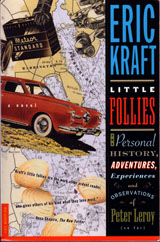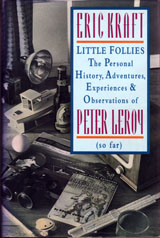

| Little Follies
The Static of the Spheres Chapter 6: Guppa’s Pigeonholes |
by Eric
Kraft, as Peter
Leroy
|

YOU CAN READ THE FIRST HALF
YOU CAN ORDER THE
|
Guppa was working on what he called his pigeonholes. One reason that Guppa was so phenomenally successful a Studebaker salesman was that he developed individual sales pitches to suit each potential customer. He didn’t wait for those potential customers to walk into the showroom, either; he went right out into the field after them and ran them down. In later years, I realized that Big Grandfather was disdainful of Guppa’s occupation because it was so definitely landbound, just as my father was landbound in his gas station, and I know that Big Grandfather didn’t think much of that. He would snort at the mention of anything automotive. Guppa, however, considered the hunt for Studebaker buyers every bit as exciting and demanding as the hunt for clams. If it wasn’t man pitted against nature, it was man pitted against man, and the reluctant Studebaker buyer could be a warier and more elusive prey than the wily bivalve. To make certain that no potential buyer was overlooked, Guppa kept a card file with information about everyone in Babbington who might eventually be made, in one way or another, to become a Studebaker owner. Guppa had a lot of confidence in himself and in Studebakers. He would eliminate a person from the file only if he was convinced that there was no hope whatsoever of an eventual sale. I know, for instance, that he kept a small stack of cards with the names of the crippled and blind in the pocket of his Sunday suit, and he would take these out after communion and say a silent prayer for the cure of each. Guppa believed that every one of the people in his active file would buy a car from him sooner or later, and that belief was the real secret of his success. It was, as he saw it, just a matter of catching the prey at the right moment or using the right lure. Of an evening, Guppa would set himself up in the living room to do his pigeonholes. He would bring a straightback chair in from the dining room and put it in front of his comfortable chair. On the seat of the straightback chair he would prop a large, shallow, cardboard carton that had in it a number of compartments formed by interlocking cardboard dividers. This carton might have been used originally to ship apples or glassware or electrical equipment. Guppa would sit in his comfortable chair, listening to the radio, or, in later years, watching television, and pull out a batch of his cards. He’d shuffle them, turn the top card, read his notes on it, and mull the situation over. After some time, he’d come to a decision about the prospects for selling a Studebaker to the person described on the card. He’d deal the card into one of the pigeonholes in the cardboard carton. Each pigeonhole represented a strategy. They were labeled in Guppa’s wavy style of block lettering. Some of the labels made sense to me, but others made sense only to Guppa: WAIT ’N’ SEE RATTLE SKELETON PROD WHEEDLE CAJOLE I was pleased and thrilled to discover, the first time I did this work for Guppa, that there was a card for me, with my own name lettered across the top in Guppa’s wavy block letters. After the cards had been randomized, Guppa would spend evenings during the next month going through them and reconsidering each one. As soon as I was able to print neatly enough to satisfy Guppa, I got even more responsibility: Guppa would save the birth announcements and obituary notices from the Babbington Reporter, and I made out cards for new-born Babbingtonians and drew black borders around the cards of the deceased. Guppa didn’t discard the dead prospects’ cards, however. He used them to warm up before he got down to serious pigeonholing, pulling a card or two from the stack of black-bordered ones and thinking about what he might have done to snare the pigeon before he or she had dropped off. Now and then during these warmups, he would heave a sigh and his eyes would mist over if the sense of loss or of lost opportunity became too great. I also copied the data from old, worn, and dirty cards onto clean new ones. This work, which I did for several years, spending some time on it whenever I visited Gumma and Guppa, gave me some familiarity with a large random sample of people in Babbington, at least with many of those who were even remotely likely to purchase a Studebaker someday. While Guppa was working with his pigeonholes, Gumma liked to pass the time manipulating large numbers with one of her slide rules. Gumma’s affection for the slide rule began when she took an off-season job in one of the slide-rule factories in Hargrove. She had worked at one job or another for nearly all her married life, but her work at the slide-rule factory was, as far as I knew, the first that she had ever really enjoyed. Before that, she had worked because Guppa was either selling too many Studebakers or too few. When he was selling too few, she worked to bring the income up to the budget, and when he was selling too many, she worked to help him keep up with the demand. Selling Studebakers in Babbington was a seasonal business, like clamming. Since the economy of Babbington was so dependent on the clam and clam by-products, such as gewgaws and driveway topping, most businesses in Babbington slipped into a torpor in the winter, when the bay was cold and choppy, and the air stung, and fewer clammies were at work. With fewer clams coming in, the work at the Babbington Clam packing plant and at Bivalve By-products, the by-product plant, would slow. Less money circulated around town, and most shopkeepers stood at their windows most of the day, looking at one another across the slushy streets. Most people in Babbington, in every line of work, expected this winter lull and considered whatever work they did seasonal. Only a few occupations — schoolteaching and bartending come to mind — provided steady, reliable employment throughout the winter, and the few people in these occupations were courted during the cold months by anyone who tried to make a living selling something. Only Guppa, the most senior of the salesmen at Babbington Studebaker, worked the year round; the others did one thing or another to make ends meet during the winter. And even Guppa, skilled as he was, found the pickings lean during the cold months. So, Gumma worked during the winter to help make ends meet. During the summer, on the other hand, when the sun was strong and the breezes were warm, the ranks of clammies would be swollen by vacationing college students, moonlighting milkmen, and many others. The clam-packing plant would go onto three shifts, working day and night, and a person could find work there just by showing up at almost any time. Then Babbington bustled, people felt flush, and Guppa would say that selling a Studebaker was as easy as shooting fish in a barrel, although when I asked him how exactly shooting fish in a barrel was done and how the fish got into the barrel in the first place, he admitted that he had never tried shooting fish in a barrel and that it might actually be pretty difficult for all he knew. During the summer, Babbington Studebaker would take on extra help, and Gumma often pitched in then just to help Guppa out. However, as soon as she began working on slide rules, Gumma fell in love with them, and she worked at a slide rule factory year-round for many years thereafter. A slide rule, which is today merely a curiosity, a relic of a simpler and cruder past, the mechanical analogue of an electronic calculator, has three main parts: the stock, the slide, and the cursor (see diagram).
Gumma was fondest of the cursor. From her first
off-season job installing screws in the shiny little metal frame that holds
the cursor in place on the stock, she had worked her way up to chief checker
in the cursor department.
|

|
||

Here are a couple of swell ideas from Eric Kraft's vivacious publicist, Candi Lee Manning: Tip the author.
Add yourself to our e-mailing list.
|
Little Follies is a work of fiction. The characters, incidents, dialogues, settings, and businesses portrayed in it are products of the author’s imagination and are not to be construed as real. Any resemblance to actual events or persons, living or dead, is entirely coincidental. All rights reserved. No part of this book may be reproduced or transmitted in any form or by any means, electronic or mechanical, including photocopying, recording, or by any information storage and retrieval system, without permission in writing from the author. “My Mother Takes a Tumble,” “Do Clams Bite?,” “Life on the Bolotomy,” “The Static of the Spheres,” “The Fox and the Clam,” “The Girl with the White Fur Muff,” “Take the Long Way Home,” and “Call Me Larry” were originally published in paperback by Apple-Wood Books. Little Follies was first published in hardcover by Crown Publishers, Inc., 201 East 50th Street, New York, New York 10022. Member of the Crown Publishing Group. YOU CAN ORDER THE
For information about publication rights outside the U. S. A., audio rights, serial rights, screen rights, and so on, e-mail the author’s imaginary agent, Alec “Nick” Rafter. The illustration at the top of the page is an adaptation of an illustration by Stewart Rouse that first appeared on the cover of the August 1931 issue of Modern Mechanics and Inventions. The boy at the controls of the aerocycle doesn’t particularly resemble Peter Leroy—except, perhaps, for the smile. |
|
||||||
| . | . |